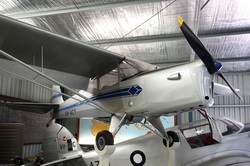Auster J-1B Aiglet VH-ACY
 Click on image for larger version
Click on image for larger version
The Auster was designed in Britain by C.G. Taylor, who had worked in the United States with the Piper Aircraft Company and had been responsible for the design of the popular Piper Club.
The Auster came into it’s own during World War 2 when it was used as an Air Observation Post (AOP), Air Ambulance and personnel transport. In the post war years a massive number of Auster variants were offered on the civilian market.
This variant, the Auster J-1 B Aiglet appeared in 1950 and around 30 of these aircraft were imported into Australia, usually in kit form for assembly by Kingsford Smith Aviation in Sydney, New South Wales.
The Museum’s Auster Aiglet, VH-ACY, arrived in Australia during 1952 and passed through a variety of owners. At one time it was used in Tasmania to ferry campers into Tasmania's unique Lake Pedder before it was flooded for a hydro-electric scheme. It was also used by the Tasmanian Royal Flying Doctor Service (RFDS).
In 1979 the Auster was retired and stored. By 1992 the aircraft had been restored to an airworthy condition when it was acquired by the Museum in an exchange for surplus aircraft parts.
TECHNICAL DATA
Crew : 1 pilot - two passengers or equivalent weight.
Power plant : 1 x 130hp de Havilland Gipsy Major 1, 4 cylinder inverted inline engine.
Length : 23'08'' (7.21m) Wingspan : 36'00'' (10.97m) Height : 6'06'' (1.98M)
Weights : empty - 1,223LBS (555kg) maximum : 2,000lbs (907kg)
Speeds : maximum - 109kt (126mph) (203 km/hr) cruise - 91kt (105mph) (169km/hr)
Range : 220 miles (350km)
